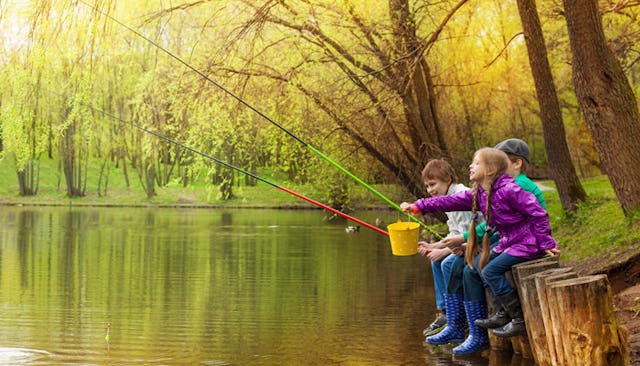Are Kids Spending Enough Time In Nature?

Sergey Novikov / via ShutterstockI grew up in West Virginia near two rivers. I spent my childhood picking my way down muddy banks, clambering over rocks and poking at bugs with sticks. If the weather was above freezing and not pouring rain, I was outside, either on foot or on my bike. My husband’s experience growing up in Florida was the same: Unless the state was on hurricane watch, kids were playing outside and poking at (larger, more horrifying) bugs with sticks.
But now we live in New York City, because here is where the jobs are, and we worry that our kids aren’t getting enough time in nature. New York is concrete and tarmac and not a lot of grass, unless we take the subway to one of the big city parks. I have to wonder if they’re missing out.
As the National Wildlife Federation notes, in the last two decades, childhood has shifted indoors. The hours of rambling and playing that my husband and I enjoyed, even as small children, aren’t possible in our current, traffic-heavy neighborhoods. Our boys play in our small local parks, but the space is pretty confined. They’re supervised the whole time—again, traffic—and my time for bench-sitting is limited. The NWF reports that the average child gets as little as 30 minutes of unstructured outdoor play, but spends seven hours using screens.
Our kids’ indoor childhoods are likely affecting their health and development. Everyone knows the alarming obesity statistics and the rates of ADHD and depression in children. Now there’s a new Chinese study that shows that extra playtime outdoors reduces the rates of myopia in children; something about the combination of sunlight and exercise is beneficial for eye health (indoor playtime didn’t have the same effect). Children who play outside are happier and healthier, but we adults are increasingly complicit in keeping them cooped up.
Part of the problem is the school day, which is long. My son’s kindergarten is a full day, much longer than the half-days that I remember as a child, and only one period is recess. On rainy or cold days, they watch movies—there isn’t the manpower or space for supervised games in the gym. Another problem is the lack of safe spaces for him to play outside without our supervision. We don’t have a yard, so any outdoor play means I accompany him to a park and hang out on the bench. My time for that is limited: I have work, household responsibilities and a younger child to watch.
Guidelines for how much time kids should spend in outdoor play vary, but it seems like at least 30 to 60 minutes of playtime a day, including 30 minutes in a park-like setting, is the bare minimum for good health. Frankly, judging from how much my son can run around on the weekends, when he would play outside all day if he could, I wonder if the guidelines shouldn’t be more like three hours a day, all in a more natural setting than our local concrete jungle gyms.
But that would cut into time for academics, like learning to read. Kindergarten is the new first grade, according to research out of the University of Virginia. Five-year-olds are now expected to do the kind of academic work that had previously been taught in first grade. This takes a toll on kids. They aren’t getting the gross motor skills and the social development that playing Duck Duck Goose or of a game of tag might offer.
Personally, I’d be fine with waiting for another year if it meant that my son could have an extra hour of recess a day. He needs exercise and games and time with his pals more than he needs to be reading Frog and Toad by himself. Books can wait. Poking things with sticks? Well, that’s urgent.
This article was originally published on